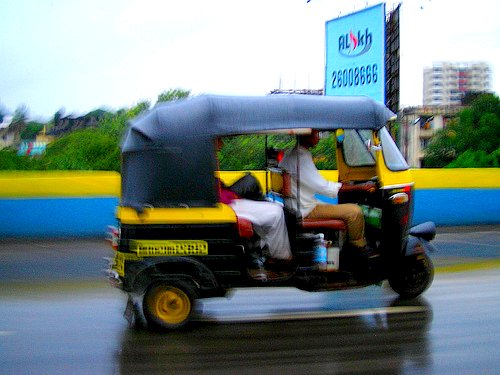An auto rickshaw (auto or rickshaw or tempo in popular parlance) is a three wheeler vehicle for hire. They typically have no doors or seatbelts. They are generally yellow or green in colour and have a black or green canopy on the top. An auto rickshaw is generally characterized by a tin/iron body resting on three small wheels (one in front, two on the rear), a small cabin for the driver in the front and seating for three in the rear. Their design varies considerably from place to place. In some locations, they have an extra plank on the seat to accommodate a fourth passenger. Hiring an auto often involves bargaining with the driver.
In some cities like New Delhi, there are larger autos called fat-fat, which is an onomatopoeic derivation of the phut-phut crackle of their exhausts. These run on fixed routes on fixed fares and are very fuel efficient. Only six passengers are allowed legally but they usually take as many as ten adults. These autos are the new incarnation of old fat-fats, which were Harley-Davidson and similar powerful motorcycles modified by removing the rear wheel and bolting a two-wheeled platform with bench seats onto the rear. These types of transport no longer exist in Delhi. In some regions they are called two-wheelers.
A majority of Indian auto rickshaws have no doors or seatbelts. Their designs vary considerably from place to place.
As a mode of transport, the auto rickshaw is turning out to be a major employer in India. All major nationalized banks of India offer loans to buy one under self-employment schemes. Major auto rickshaw manufacturers in India include Bajaj Auto and Force Motors (previously Bajaj Tempo). A two-wheeler major, TVS Motors, has announced it will enter the auto rickshaw market with a technologically updated and a less polluting vehicle, in early 2006. Not restricted to cities, auto rickshaws are also prevalent in large numbers in Indian villages and in the countryside.
There is an initial charge at the beginning of a ride then the price normally increases in proportion to the distance . It is mandatory that the initial charge be set at a value given by the government.

No comments:
Post a Comment